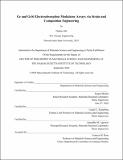Ge and GeSi electroabsorption modulator arrays via strain and composition engineering
Author(s)
Ma, Danhao.
Download1227031946-MIT.pdf (6.852Mb)
Other Contributors
Massachusetts Institute of Technology. Department of Materials Science and Engineering.
Advisor
Jurgen Michel, Lionel C. Kimerling and Anuradha M. Agarwal.
Terms of use
Metadata
Show full item recordAbstract
Electronic and photonic integrated circuits serve as a promising platform for telecommunications and sensing applications. Electroabsorption modulators allow fast modulation, small device footprint, and low power consumption. Epitaxially grown GeSi films on SOI substrates are a suitable materials platform for integrated modulator applications. A modulator's operation wavelength adjustment and its system integration for broadband modulation are two major challenges of fabricating on-chip modulator arrays for telecommunication. Unlike Si MZI modulators, GeSi electroabsorption modulators are not broadband due to its limited working region near absorption edge for the Franz-Keldysh effect. Optimization of a modulator material for a target wavelength can be achieved by tuning material composition or applying strain to the material. In order to realize an integrated system with a broadband modulation, multiple electroabsorption modulators need to be fabricated individually and assembled onto a chip in a conventional approach. Each fabrication step adds cost to design and processing. Integrating more modulators for multiple operating wavelengths allows a broader optical band coverage and higher optoelectronic data processing capacity, which is desirable with lower cost, simpler layout, and easier electronic and photonic circuits integration. In this thesis work, a one-for-all strained GeSi modulator array design is proposed and demonstrated to cover a broad telecommunication band with multiple modulators designed and fabricated simultaneously in the same process flow. A stressor layer applies a homogeneous strain to a waveguide modulator. By changing a modulator width, strain in the modulator changes, tuning the material bandgap, therefore, adjusting the modulator operation wavelength. Modulators made of the same material can operate at various wavelengths with the same stressor layer with a simplified layout and device process flow. The matrix of investigation consists of two compositions (Ge and Ge₀.₉₉Si₀.₀₁) and three types of strain (compressive, tensile, and no strains). Individual GeSi EAMs with waveguide width less than 2 [mu]m have demonstrated an improved extinction ratio/insertion loss value from 1 to 1.7, which is the highest value among Si Mach-Zehnder, and GeSi electroabsorption modulators. Strained Ge₀.₉₉Si₀.₀₁ modulator arrays have demonstrated a broad optical bandwidth of ~100nm in C- and L-bands in telecommunication. An ultralow insertion loss of 2dB and high modulation speed above 100 GHz is achievable with minor improvements in electrode design. An increase in Si composition to 4% allows a strained Ge₀.₉₆Si₀.₀₄ modulator array to cover the optical wavelength from 1300nm to 1450nm. Strained GeSi modulator and detector arrays can be fabricated in the same process flow with the same stressor layers to achieve an integration of transmitters and receivers on a single chip with a simplified design layout and fabrication procedure. That presents a promising platform for integrated photonic transceivers with an ultrawide optical coverage in the entire telecommunication bands.
Description
Thesis: Ph. D., Massachusetts Institute of Technology, Department of Materials Science and Engineering, 2020 Cataloged from student-submitted PDF of thesis. Includes bibliographical references (pages 151-159).
Date issued
2020Department
Massachusetts Institute of Technology. Department of Materials Science and EngineeringPublisher
Massachusetts Institute of Technology
Keywords
Materials Science and Engineering.